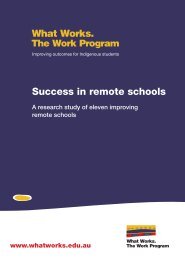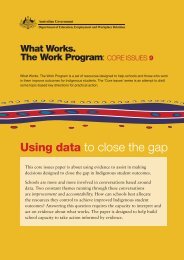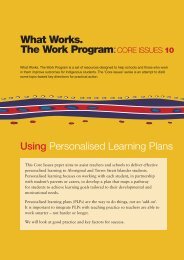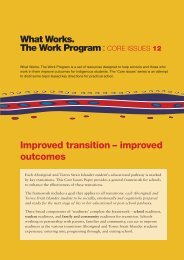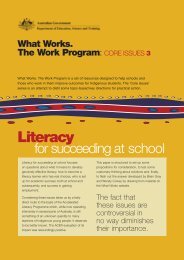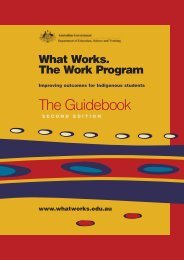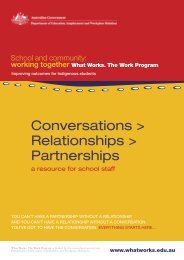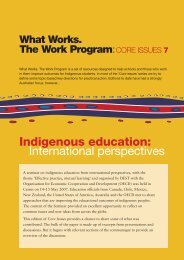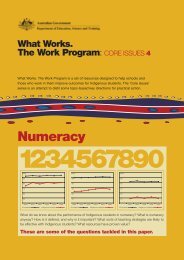Bound for Success Scope and Sequence Statements
Bound for Success Scope and Sequence Statements
Bound for Success Scope and Sequence Statements
- No tags were found...
You also want an ePaper? Increase the reach of your titles
YUMPU automatically turns print PDFs into web optimized ePapers that Google loves.
SCIENCEWorking Scientifically(Note that this str<strong>and</strong> should be addressed simultaneously with all Science content str<strong>and</strong>s)Concept In Year 1the student:In Year 2the student:In Year 3the student:In Year 4the student:In Year 5the student:In Year 6the student:In Year 7the student:In Year 8the student:In Year 9the student:Science as humanendeavourThe nature of Scienceas a human activity• Cooperates with others in agroup or pair setting.• Knows that scientists oftenwork together in groups tosolve problems (just asstudents work together inclass).• Identifies throughengaging in relevantinvestigations, that scienceideas are part of their dailylife; recognizes that thingsthey already know aboutoutside school are‘science’ (e.g. pets needfood <strong>and</strong> water <strong>and</strong> theT.V. won’t work withoutelectricity).• Knows that science is apart of the daily lives of allpeople in the community(e.g. football is not usuallyplayed in summer becauseit’s too hot <strong>and</strong> players canbecome sick because of theheat, <strong>and</strong> people userefrigerators to keep foodcold so it doesn’t spoil).• Identifies the place ofscience in the work ofpeople in their community;knows that many people inthe community (e.g.doctors, chemists,electricians, plumbers,gardeners, mechanics) usescience ideas in their dailywork.• Knows that scientists playa major role in determiningmany of the things we doin our daily lives (e.g.says “we should try not touse too many plastic bagsbecause scientists tell usthey are bad <strong>for</strong> theenvironment” <strong>and</strong> “we tryto recycle <strong>and</strong> use lesswater because scientiststell us we should”).• Knows that scientificknowledge can beimportant in helping us tolive (e.g. being able to useelectricity) but that careneeds to be taken to makesure that it is not usedinappropriately.• Knows that things thathappen around themeveryday can be explainedby science ideas (e.g. themoon appears to changeshape on different nights;their food <strong>and</strong> drink givesthem energy to do things;their pets need food <strong>and</strong>drink to survive; a carwon’t go without petrol;they ‘grow out of’ theirshoes <strong>and</strong> clothes).• Knows that scientific ideashelp to explain how thingsmight work (ie products<strong>and</strong> tools such asappliances they useincluding bicycles,toasters, T.V.) have beendeveloped through theapplication of science.• Knows that scientific ideasplay a part in improvingthe quality <strong>and</strong>sustainability of life (e.g.using modern medicine tocombat disease <strong>and</strong>generating electricity fromthe heat of the sun).• Knows what a ‘scientist’ is<strong>and</strong> can list occupationsthat engage with science(e.g. inventor, CSIROscientist, agricultural <strong>and</strong>medical researcher,laboratory technicians,science teacher, universityresearcher).• Knows that people usesimple science ideas tosolve problems in daily life(e.g. says ‘Mum puts breadin the fridge to stop itgoing mouldy’ <strong>and</strong> ‘Wecan’t put the bottle of fizzydrink in the freezerbecause it will burst whenit freezes’).• Shows an underst<strong>and</strong>ing ofhow science helps us inour daily lives by giving avariety of examples ( egsays “without a mobilephone I’d have to find aphone box to get mum topick me up from school”<strong>and</strong> “email is a mucheasier way to contact myfriends” <strong>and</strong> ‘iPods aremuch more portable thanCD players”).• Knows that individualsengage in, <strong>and</strong> findscientific work rewarding,<strong>for</strong> a variety of reasons;citing contemporaryAustralian work in scienceincluding genetic researchon the human genomeproject <strong>and</strong> the discoveryof new objects in theuniverse.• Recognizes that scientificunderst<strong>and</strong>ings havechanged over time ( egdevelopment of bettertechnology <strong>for</strong> the purposeof study in astronomy hasresulted in scientificknowledge of the Universeincreasing dramatically,while medical technology<strong>and</strong> improvedunderst<strong>and</strong>ings of how thebody works have led toimproved treatments ofdiseases).• Underst<strong>and</strong>s thatindividual cultures mayhave different views inrelation to scientificpractices in areas such asmedicine (e.g. Indigenous<strong>and</strong> Asian culturessometimes have their ownbeliefs regarding illness<strong>and</strong> healing).• Knows that science ideascan <strong>for</strong>m the basis of manysolutions to challenges inour everyday lives (e.g.says “We need to wash ourh<strong>and</strong>s to help avoid thespread of disease” <strong>and</strong> “weshould eat healthy food<strong>and</strong> exercise to avoiddisease <strong>and</strong> obesity” ).HPE• Knows that science workis highly valued in thecommunity <strong>and</strong> can nameseveral historical orcontemporary Australianscientists (e.g. those oncurrency, Ian Fraser) <strong>and</strong>knows about theirachievements.• Knows that science ideascan be used to solveproblems <strong>and</strong> explainevents or phenomena ineveryday life (e.g. says“solar hot water systemsare ideal to save money onenergy bills” or explainswhy rain accompanies lowair pressure, <strong>and</strong> recyclingof water <strong>and</strong> other naturalresources is needed helpkeep our planetsustainable).• Appreciates that scienceprovides rewarding careers<strong>and</strong> lists some of these• Recognizes that the workof contemporary scientistsis multi-disciplinary <strong>and</strong>collaborative.• Knows that people ofdiverse cultures havecontributed to <strong>and</strong> shapedthe development of science( eg underst<strong>and</strong>s theimportance of scientistssuch as Mendel, Galileo,DaVinci, Mendeleev, theCuries, Fleming).Select <strong>and</strong> applyscientific knowledge,skills <strong>and</strong>underst<strong>and</strong>ings acrossa range of contexts indaily life• Makes observations aboutthings they can see, feel,taste, touch <strong>and</strong> smelldirectly or indirectly(including on T.V. or inbooks), experiencing real<strong>and</strong> concrete objects <strong>and</strong>events.• Describes their scientificobservations in simpleterms (e.g. says “theclouds are big’ or ‘thesnail shell is round’ or‘when I clap it makes anoise”).• Listens <strong>and</strong> responds toothers sharing theirobservations <strong>and</strong> to teacherexplanations <strong>and</strong>responses.• Asks questions to find outwhy things happen.• Speaks about any priorexperience or knowledgethey may have about whatthey are investigating,making connectionsbetween daily life <strong>and</strong>what they are doing in‘science’.• Observes using their fivesenses.• Draws a diagram of theirobservations with simplelabels to communicate toothers (ie as distinct from apicture).• Develops the ability toinfer from theirobservations (e.g. says“that feather on the groundmeans a bird is near” <strong>and</strong>“that snail trail means asnail has gone past here”).• Listens to <strong>and</strong> respects theideas of others.• Interprets a partner’sdiagram <strong>and</strong> explains theirown to others.• Identifies things that arecommon to their diagram<strong>and</strong> someone else’s work.• Uses simple scientificterms including ‘observe’,‘measure’ <strong>and</strong> ‘investigate’when communicatingin<strong>for</strong>mation aboutobservations.• Begins asking questions<strong>and</strong> making predictionsrelated to their everydayexperience.• Knows that as well asinferences, predictions arepossible from observations(e.g. knows that a showerof rain may result in beingable to find snails outafterwards; that lots ofheavy dark clouds mayresult in rain; that beingable to see the sun in thesky means that sunburn isa possibility).• Describes theirobservations with othersusing simple labelleddiagrams <strong>and</strong> makescomparisons between theirown <strong>and</strong> others’ work byidentifying similarities <strong>and</strong>differences.• Uses scientific words (e.g.thermometer, temperature)during investigations.• Recognises scientificaspects of their everydayactivities <strong>and</strong> theapplication of science intheir own lives; knows that• Knows that some thingsaround them that theyobserve can change (e.g. anail or pair of scissors cango rusty or food can spoil,their feet <strong>and</strong> pets getbigger as they grow) <strong>and</strong>they begin to recognizethat real <strong>and</strong> concretethings don’t always staythe same.• Names features of thingsthey observe (e.g. says‘this material is soft <strong>and</strong>fluffy’ <strong>and</strong> “the metal ruleris hard <strong>and</strong> shiny”).• Knows at a simple levelthat things that happenaround them everyday(e.g. changes in theweather, growth of theirgarden, night <strong>and</strong> day,drinking through a straw)can be explained byscience ideas.• Develops their scientificvocabulary to describetheir observations.• Begins to know thatchanges to things theyobserve occur <strong>for</strong> a reason(e.g. changes in terms ofcause <strong>and</strong> effect).• Describes changes theyobserve (e.g. says ‘theapple went brown after itwas cut’ <strong>and</strong> ‘the jellywent hard after a longtime’) recognising thattime is a factor.• Describes <strong>and</strong> comparesproperties of concretethings based onobservation (e.g. says ‘thispiece of paper is muchthicker that that one’).• Applies their scientificunderst<strong>and</strong>ing to theirexperiences <strong>and</strong> todescribe how products <strong>and</strong>tools have been developed.• Describes how people in awide range of occupations<strong>and</strong> cultures use science intheir work <strong>and</strong> leisure.• Knows the relationshipbetween observations <strong>and</strong>changes that occur (ie theyunderst<strong>and</strong> cause <strong>and</strong>effect saying ‘the icemelted because it gothotter’ or ‘the plant diedbecause it didn’t have anywater’).• Compares the properties ofthings based on havingdone some testing ratherthan from the obvious useof their five senses (e.g.says ‘this tee shirt is morestretchy than that one’).• Makes concretegeneralizations as a resultof their observations <strong>and</strong>,having made these <strong>and</strong>worked out ‘a rule’, canapply it to makepredictions (e.g. says “allplants will die if they don’thave water” <strong>and</strong> “ice <strong>and</strong>ice creams will melt if thetemperature gets hotter”).• Demonstrates that usingscience ideas can help tosolve relevant problems indaily life ( eg says “I needto put my s<strong>and</strong>wiches in acool place at school sothey don’t go bad”, <strong>and</strong>“We can’t go out in the sunwithout a hat because wemight get skin cancer”,<strong>and</strong> “My pen leaked inkeverywhere because it gotreally hot in my school bagwhen I left it out in thesun; next time I will put itin the shade”).• Explains <strong>and</strong> evaluateshow the use of science <strong>and</strong>technology has changedthe ways people live (e.g.underst<strong>and</strong>s <strong>and</strong> explains• Generalizes from theirobservations <strong>and</strong> frompredictions <strong>and</strong> appliesideas to other contexts orsituations.• Attempts to explainobservations in terms ofnon observable, or abstractideas ( eg says “somethingmight be happening thatwe can’t see”, <strong>and</strong> “sincethe plant is still alive <strong>and</strong>we didn’t water it maybewater might be getting intothe plant from somewhereelse”, <strong>and</strong> suggests somepossibilities such as ‘fromthe air’)• Explains their observations<strong>and</strong> interactions betweenevents or variables interms of a single abstractidea or at the particle level(e.g. says “the plant muststill be alive even thoughwe haven’t watered itbecause it is absorbingwater through it’s leaves”<strong>and</strong> “carbon dioxide <strong>and</strong>water come into the plantcells <strong>and</strong> through achemical reaction arecombined to make food <strong>for</strong>the plant”).<strong>Bound</strong> <strong>for</strong> <strong>Success</strong> <strong>Scope</strong> <strong>and</strong> <strong>Sequence</strong> <strong>Statements</strong> V2 Page 46 Working Document Semester One 2007



